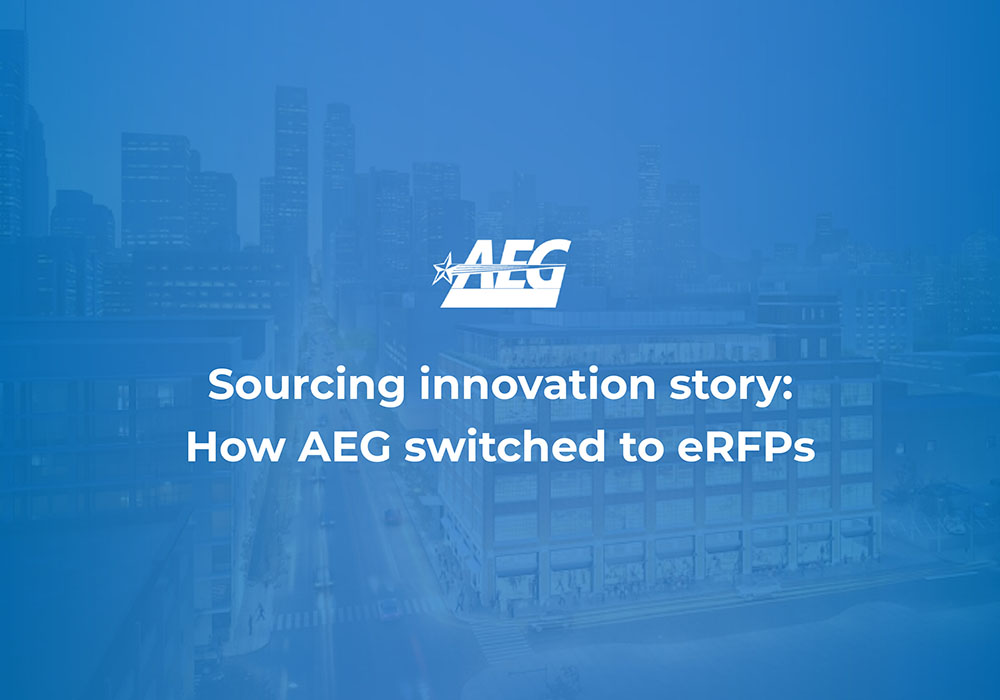If you follow procurement trends, you’ve almost certainly heard the term lean procurement. Indeed, over the last few years, there have been countless discussions of the topic in articles, analyst research, podcasts and industry groups. Despite the abundance of information, the definition and practical application of lean procurement is still abstract for many procurement professionals.
In this blog, we’ll explore lean procurement and what the approach may mean for you. First, we’ll define the term and explore the history of lean practices. Next we’ll share the three basic steps to adopting lean procurement and an example of how one company applied lean thinking to the RFP process. Finally, we’ll offer additional resources for further research.
- What is lean procurement?
- 3 basic steps to lean procurement
- Lean procurement example
- Resources for additional research
What is lean procurement?
Lean procurement, also known as lean purchasing or lean sourcing, is an approach to procurement that focuses on maximizing value by improving efficiency and limiting waste.
If you think that still sounds vague or obvious, you’re right. It is. The definition of lean procurement is broad because it hinges on continual improvement — which looks different for every organization. Consequently, you’ll find the term used in many ways. In fact, an article from Procurement and Supply Australasia (PASA) offers six differing definitions.
In addition to varying definitions, sentiments about lean procurement also run the gamut. There are procurement leaders who believe that a lean procurement mindset should be every organization’s default. Alternatively, some practitioners think of it as a theoretical approach that’s aspirational but not always practical to put into practice. And, still others express skepticism, viewing lean procurement as an attempt to reframe perceptions amid difficult circumstances including labor shortages, a highly-competitive market and ongoing global uncertainty.
To better understand the reality and potential of lean thinking as it applies to your procurement processes, it’s important to dig deeper into the details.
The background of lean methodology
No matter what form they take, all lean procurement practices have the same origin story in manufacturing. Indeed, some say that the invention and adoption of assembly lines by Henry Ford in the early 1900s was the first application of lean thinking. However, it wasn’t until the 1990s when a book actually coined the term ‘lean’ as it relates to business operations.
Written by James Womack and Daniel Jones, The Machine That Changed the World: The Story of Lean Production reported findings from a five-year study of Toyota’s production model and philosophy. Over the next two decades, the duo released several more books further refining and researching the approach. Additionally, Womack founded the Lean Enterprise Institute (LEI), a non-profit organization that provides resources for businesses who want to put lean into action.
LEI recommends that practitioners continually keep three key elements in mind when adopting a lean mindset: purpose, process and people.
Purpose: What is the primary goal of your organization? What value do you provide to customers?
Process: How do you accomplish your goals and deliver value to customers in the most efficient way possible?
People: Who is responsible for the processes that create value for customers?
Having a lean mindset means making decisions with your organization’s core purpose or customer in mind. Then, you must define processes and eliminate steps along the way that don’t serve that purpose. Finally, you assign ownership to team members who are then responsible for process management and optimization. The lean approach is most commonly applied to manufacturing, supply chain management and procurement. However, the principles can be used in any process.
Technology and lean procurement
As you might expect, the evolution of technology has only increased the power and potential of lean thinking. The lean thinking goal of removing manual or administrative steps that don’t add value works hand in hand with popular procurement technology. For example, RFP management software, spend management technology and contract management tools all prioritize automating and streamlining workflows and reporting.
A McKinsey study estimated that procurement professionals spend around 40 percent of their time on administrative tasks. While necessary, these low-value steps in crucial processes keep practitioners from spending time on higher-value, strategic work. This is where lean thinking paired with technology can make a tremendous difference.
3 basic steps to lean procurement
1. Get ready to ask ‘why?’ and ‘what if?’ (a lot)
Before you start to explore ways to incorporate lean thinking into your sourcing strategy, it’s important to reset your thinking. It’s easy to rely on bloated and inefficient processes because they’re comfortable. Indeed, people do things all the time without knowing why just because it’s the way it’s always been done.
An important part of lean procurement is mapping and reviewing processes. At each step, ask why. Why do you do this? What purpose does it serve? Is it crucial? Then, ask what if. What if you removed the step? Would there be a negative impact or is the risk too high? How does this step deliver value to the process and serve the organization’s purpose? What if you shortened the step or tried a new approach?
2. Map procurement processes
With the right mindset, it’s time to start mapping your processes. From beginning to end, your procurement cycle is full of processes. So, it can be a challenge to know where to start.
For simplicity, it may be easiest to begin at the beginning and evaluate your procurement intake process. Map every step of the process for every person involved. How does a user submit a procurement request? Who handles it? How is it evaluated? Who verifies approval?
Once you’ve mapped the process, consider each step. Ask yourself a series of questions. Is this step valuable or would the process remain mostly unchanged if it was removed? Does this step depend on the step before or can it be done simultaneously? Is there technology that could automate or make this step easier?
Examples of procurement processes to apply lean thinking to:
- Procurement project intake
- Requirements discovery
- Vendor research and selection
- RFP management
- Invoice management
- Contract management
- Vendor performance evaluations
- Spend analysis and reporting
Ideally, by breaking down your processes you can start to identify steps that don’t serve your goal or don’t deliver enough value to justify the time they take.
3. Make changes, appoint an owner, monitor and review
Once you’ve identified ways to save time and eliminate waste, you have to implement the changes. First, update your internal procurement policy. Then, inform stakeholders of the updated process as well as the logic behind it. Additionally, let them know who owns and manages the process.
Ideally, you’ll simply save time and be more efficient. However, not every change made will work. So, it’s important to give stakeholders a way to provide feedback or voice a concern. Lean procurement is all about continuous improvement and optimization. Accordingly, it’s a good idea to review process changes regularly to ensure they’re working as intended.
Lean procurement example
AEG — Automated RFPs
Recently, AEG, the world’s leading sports and live entertainment company, embarked on a lean procurement project with the goal of streamlining their RFP process. Across multiple locations and teams, they mapped their process and explored ways to apply RFP automation.
“We were in the manual and paper days. Each facility had their own templates, their own docs and their own terms and conditions. We realized we needed to standardize and streamline the process and create an entire library of different scopes of work. Although there are a lot of commonalities between the services and functions that were performed across the different venues, they were re-creating the wheel every single time.” — Scott Bosarge, senior vice president of business services at AEG.
Eventually, they adopted an RFP management system to reduce manual steps and streamline their process. The results? AEG reports that they cut their RFP timeline by up to 50 percent.

Read the full AEG case study here.
Resources for additional research
As mentioned above, there are countless resources available to help you deepen your understanding of lean principles and how they apply to procurement. Here are a few of our favorite resources for further exploration.
Lean Enterprise Institute
While not specific to procurement, this website provides a wealth of free resources and information about applying lean thinking to any process. Organized by topic, there are dozens of articles available to browse as well as a helpful lexicon of terms.
Webinar — Improving the procurement process using Lean
This webinar is a fast and easy way to see how lean procurement applies to a particular industry. In the video, the presenter offers an overview of how lean principles apply to the legal procurement process.
Article — Purchasing power: Lean management creates new value in procurement
From analyst McKinsey, this article provides an interesting perspective on lean procurement, framing it as a way for organizations to drive innovation.
“Properly applied, the disciplines and systemic thinking of lean management can become a strategic weapon: aligning purchasing more tightly to internal customers’ real interests, helping leaders rethink the end-to-end procurement process (from suppliers through to manufacturing and ultimately to external customers), and transforming the effectiveness of strategic procurement activities.”
While lean thinking may seem obvious, it’s an important habit to cultivate. It’s easy to get comfortable and stop applying critical thought to procurement processes that feel like second nature. Ultimately, it’s up to practitioners to ensure that lean procurement isn’t just a buzzword, but instead is a daily mindset of focusing on purpose, process and people.



